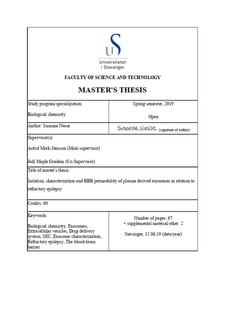| dc.contributor.advisor | Mork-Jansson, Astrid | |
| dc.contributor.advisor | Maple Grødem, Jodi | |
| dc.contributor.author | Nesse, Susanne | |
| dc.date.accessioned | 2019-10-22T13:26:41Z | |
| dc.date.available | 2019-10-22T13:26:41Z | |
| dc.date.issued | 2019-06 | |
| dc.identifier.uri | http://hdl.handle.net/11250/2623774 | |
| dc.description | Master's thesis in Biological chemistry | nb_NO |
| dc.description.abstract | Exosomes have been of increasing interest for researchers due to their potential as a therapeutic drug delivery system. Refractory epilepsy is a drug-resistant form that affects 30% of epilepsy patients. There is no common reason for their resistance, therefore targeted drug therapies may be the best option for improving treatment outcomes. Exosomes are able to cross the blood-brain barrier (BBB) and deliver their cargo still intact to a specific target, making them a promising nanocarrier. At the same time, there exist many challenges in understanding the immune reactions and components of the exosomes.
The lack of an efficient standardized method is a major challenge for utilizing exosomes as a drug delivery system. Size exclusion chromatography (SEC) was tested and optimized to isolate endogenous exosomes from blood plasma. Ultrafiltration was used to purify the samples. The influence of storage conditions on exosomes was tested in order to keep exosomes stable until use. Protein content of vesicle fractions was analyzed by coomassie brilliant blue (CBB) and mass spectrometry (MS). Furthermore, exosomes were characterized by dynamic light scattering (DLS) and western blotting (WB). Exosome uptake in rat astrocytes was studied by confocal microscopy.
It was shown that plasma derived exosomes can be isolated by SEC, and that residual protein was successfully removed by ultrafiltration (100K). Short-term storage of exosomes was confirmed to be best at 4C or room temperature (20C). Albumin, immunoglobulin and fibrinogen beta were identified as highly abundant proteins in the vesicle fractions. Fraction 10, 11 and 12 were identified as exosome fractions based on size distribution analysis. Z-average diameter and poly-dispersity (PDI) confirmed fraction 10 and 11 to be exosome fractions with high particle homogeneity. The exosome specific protein, tetraspanin CD9, was identified in fraction 13. Confocal results suggest that exosomes are taken up by rat astrocytes, indicating that exosomes are able to cross the BBB and deliver their cargo. | nb_NO |
| dc.language.iso | eng | nb_NO |
| dc.publisher | University of Stavanger, Norway | nb_NO |
| dc.relation.ispartofseries | Masteroppgave/UIS-TN-IKBM/2019; | |
| dc.rights | Navngivelse 4.0 Internasjonal | * |
| dc.rights.uri | http://creativecommons.org/licenses/by/4.0/deed.no | * |
| dc.subject | biologisk kjemi | nb_NO |
| dc.subject | SEC | nb_NO |
| dc.subject | exosomes | nb_NO |
| dc.subject | extracellular vesicles | nb_NO |
| dc.subject | drug delivery system | nb_NO |
| dc.subject | exosome characterization | nb_NO |
| dc.subject | refractory epilepsy | nb_NO |
| dc.subject | epilepsi | nb_NO |
| dc.subject | biokjemi | nb_NO |
| dc.subject | the blood-brain barrier | nb_NO |
| dc.subject | biochemistry | nb_NO |
| dc.title | Isolation, characterization and BBB permeability of plasma derived exosomes in relation to refractory epilepsy | nb_NO |
| dc.type | Master thesis | nb_NO |
| dc.subject.nsi | VDP::Mathematics and natural science: 400::Basic biosciences: 470::Biochemistry: 476 | nb_NO |

